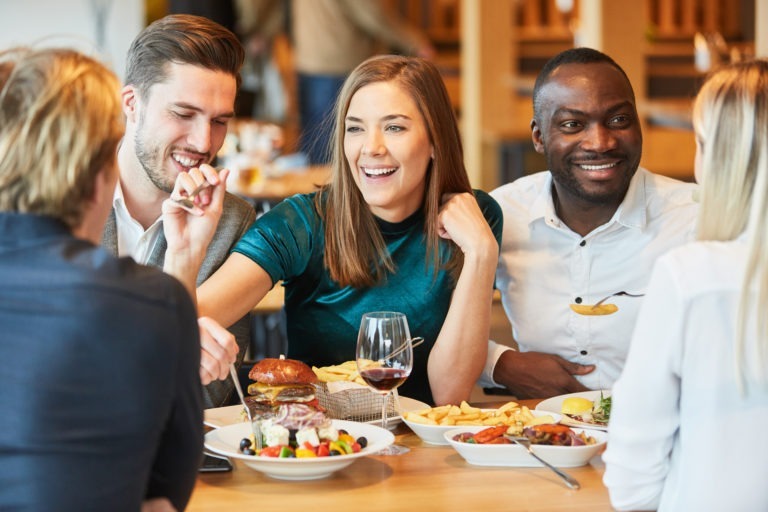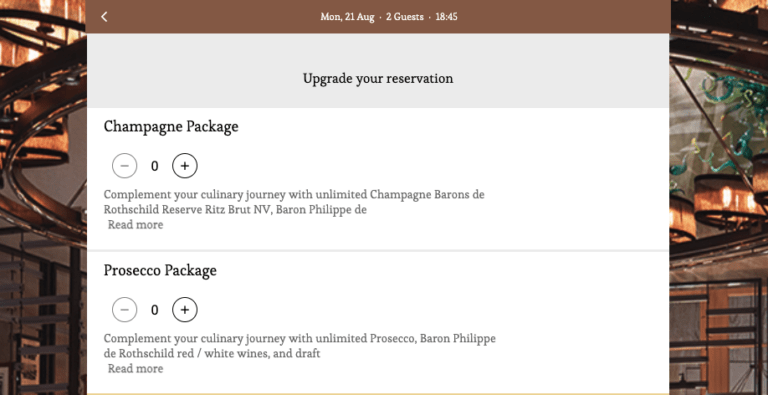Singapore Restaurant Marketing Guide: 5 Customer Profiles Revealed
Sevenrooms
5 min read
Aug 22, 2023

Sevenrooms
5 min read
Aug 22, 2023

Singapore’s food scene is a dynamic blend of tradition and innovation. Award-winning street food, elegant fine dining and cocktail-making robots compete for diners’ dollars. But the secret to standing out — and keeping your restaurant thriving — is knowing your customers.
Below, we’ve created five restaurant customer profiles based on SevenRooms’ Discovery & Booking research on Singaporean diners.
With this insight, you’ll learn how to tailor your marketing efforts to each persona to deliver personalised experiences and hyper-targeted campaigns that get customers in the door and keep them coming back.
Before we get into the restaurant customer profiles, let’s discuss why they’re so important in the first place.
Attracting new and repeat customers in Singapore can be challenging, even for the most experienced marketer. But knowing your customer — their preferences, pain points and demographic data — will make your marketing more impactful and help fill your restaurant.
Consider Singapore’s substantial expat community, which numbered 1.56 million in 2022, compared to 3.55 million citizens. Your marketing strategy should reflect this diversity by ensuring your communications, from digital to in-restaurant, are inclusive.
For example, offering menus in multiple languages will show you respect Singapore’s diverse population and cater to their needs.
In addition, knowing your diners’ habits and preferences, from their go-to dish to ideal table, will create personal connections that lead to long-term loyalty — and set your restaurant apart from the competition.
FYI: When it comes to dining at a new restaurant, Singaporeans prioritise three key factors: convenience (78%), quality cuisine (74%) and personal recommendations (47%).
Understanding psychographics — the categorisation of individuals based on attitudes and ambitions — can translate to more reservations and revenue.
SevenRooms’ customer behaviour report on Singaporean diners revealed crucial pyschographic insights, from preferences to deal-breakers, for restaurant marketers.
Use the following five personas to create restaurant customer profiles that inform future marketing decisions, strategies and promotions.
Nearly one-third of Singaporeans identify as spontaneous diners, meaning they forgo reservations in favour of eating on the fly. Whether it’s a last-minute business lunch or a sudden craving for brunch, they dine out frequently but rarely make plans in advance.
Use the following tips to attract spontaneous diners to your restaurant and encourage repeat visits:
Every passerby is a potential customer. Send a multilingual staff member outside with free samples or promotional flyers to attract walk-ins. Use an outdoor display board to announce daily specials, ongoing promotions and menu items in multiple languages to appeal to expats and citizens.
Tourist attractions, city centres and shopping destinations are ideal for handing out flyers and menus to attract walk-ins. Partner with local establishments to leave your flyers by the register or front door. It’s also helpful to include a coupon to help entice spontaneous diners to come in for a meal. Always include your reservation link, phone number and address on any marketing materials.
Spontaneous diners are driven by convenience. Google’s near me feature is a powerful tool that helps diners find restaurants closest to them. To reach local customers, your restaurant needs to appear on these “near me” searches.
First, claim or verify your Google Business Profile and check that any existing information is correct. Ensure your profile includes your restaurant’s name, address and phone number (NAP) and upload photos and menus to optimize for local search and customer experience.
Add a persuasive business description, aim for five-star reviews and list your restaurant in popular Singapore third-party directories like Yelp and HungryGoWhere to improve your chances of reaching locals.
If your restaurant is packed with reservations or often has a wait, investing in a virtual waitlist system is a great way to streamline the waitlist process and collect guest data.
A virtual waitlist system, like SevenRooms, makes it fast and easy for guests to add themselves to your list through your website, QR code or text.
When a guest joins the waitlist, they provide their phone number, email address and notes, which creates a profile you now have in your database. You can then tailor your service and future promotional efforts to this diner to entice them to come back in.
Special occasion diners, which account for 23% of Singaporeans, dine out mainly for holidays and events. From cultural celebrations to anniversary dinners, they heavily research restaurants to ensure the venue is the right fit.
Here’s how to target special occasion diners:
Guest data is a differentiator that allows you to create unforgettable dining experiences tailored to each customer. Your staff can collect data, such as birth dates, anniversaries, milestones, guest habits and preferences, via reservations or online orders.
Customer relationship management (CRM) software is a powerful tool for collecting and storing this data, which can be used for guest retention. For example, you can use this data to send highly personalised offers, like a birthday greeting with an exclusive discount, to entice the special occasion diner to book now.

As you collect guest data, you can create profiles based on diner preferences and habits that allow you to send targeted events and promotions. For example, tracking guest birthdays and anniversaries allows you to invite them in the following year with a targeted email: “It’s your birthday month! Reserve a table now and get 10% off your meal”.
If you’re hosting a special menu for an upcoming holiday, promote your menu and deals at least a month in advance to entice prospective customers to stay in town and book your restaurant to celebrate.
For example:
Ask guests if they’re celebrating a special occasion when booking a reservation and present them with exclusive upgrade options. Maybe it’s a champagne toast upon arrival, a table with the best view or a customised dessert.
These special touches will impress your guests and bring in more revenue. Even better? The data will be stored in your CRM for future marketing opportunities and upsells.
Below, Singaporean restaurant, Colony in the Ritz Carlton, Millenia, uses SevenRooms’ reservation system to entice special occasion diners with Champagne and Prosecco upgrades when booking. This not only brings in more revenue to the restaurant but enhances the guests’ experience.

Pro tip: The special occasion diner reads reviews, scours menus and pours over guest photos before making a decision. Create a review management strategy and ensure your website is up to date to help secure reservations from this customer.
SevenRooms’ report revealed that ‘less is more’ diners, which account for 23% of Singaporeans, are deeply loyal to a few establishments and don’t feel the need to stray. Exceeding their expectations can turn them into regulars — but the key is customer data to ensure every visit is better than the last.
Here’s how you can appeal to this loyal diner:
Elevating the dining experience for regular customers is crucial. Recognizing and rewarding loyalty will show guests you value their patronage and help ensure repeat visits. The trick here is using a CRM to collect guest data and build robust profiles.
For example, you can use your CRM to take notes on regulars — do they always order a specific wine or dish? Maybe they never leave without ordering their favourite dessert. Have staff take detailed notes to build customer profiles they can use to deliver impressive service.
This data allows staff to usher guests to their preferred table without having to ask or pour their go-to Pinot before they can even sit down. It also ensures you can continue to exceed their expectations every time, even across multiple locations.
SevenRooms’ CRM creates robust guest profiles using tags based on customers’ dining preferences and behaviours.
Show appreciation for regular customers with perks that reward their loyalty. Let guests earn points with every purchase, which they can redeem for a free appetiser, cocktail or BOGO entree. Another option is to offer diners a discount on their next meal after they’ve spent a certain amount or visited a certain number of times in a month.
Email personalised offers to show how much you appreciate your regular customers. Personalise the email with each guest’s name and invite them to exclusive wine and spirit tastings, new menu sneak peeks, VIP chef’s table experiences and more.

Regulars expect consistent, high-quality service across touchpoints. Offer multiple ways to book a reservation, such as by phone, SMS and online, so they can easily grab a table, whether at home or on the go.
A white-label CRM system with reservation software is your best bet so you can customise your business’s branding to ensure a cohesive guest experience. Your guests should be able to easily pick a time and date, add a special request, input their information and pre-pay for any applicable upgrades.
For example, Singaporean restaurant LAVO uses SevenRooms’ reservation widget to make the booking process seamless for customers. If the requested time isn’t available, the widget saves the sale by offering multiple options: select a different date, make a special request or order takeaway.

Why play favourites when you can go somewhere new every night? SevenRooms’ report found that 15% of Singaporeans classify themselves as influencer diners, meaning they dine out often and prioritise trying new spots.
Here’s how to attract influencer diners and increase repeat visits:
Use Instagram, TikTok and Facebook to boost your odds of attracting this hot-spot-seeking customer. Create over-the-top menu items and feature them on your social channels. Try a colourful cocktail to celebrate Singapore’s Dragon Boat Festival or a special menu of sweets for Deepavali, the Festival of Lights. Top it off with a custom hashtag to encourage user-generated content to further your reach.
Pro Tip: Be sure to include your direct reservation link or landing page offer in your social profiles and posts to make booking a reservation easy.
For a buzzy PR stunt, create a pop-up restaurant in an unlikely spot or during an event. Serve a limited, Instagram-worthy menu and give it a theme — a trending topic, holiday or seasonal event works well. Promote the event heavily on social media to help it go viral and grab the attention of influencer diners.
Restaurants with five-star reviews are irresistible to the influencer diner. Ask for reviews through SMS and email using an automated marketing solution like SevenRooms. This software allows you to send automated post-visit feedback surveys to every diner, simplifying the process for your team and helping to improve the customer experience.
Respond to positive and negative feedback to show customers you care about their experiences and offer to make it right when a customer leaves a less-than-stellar review. Review management software can help you manage reviews from multiple channels in one place.
Hire a PR firm to get your restaurant featured in trendy restaurant publications like TimeOut and epicure magazine, and TV news spots on the best places to eat in Singapore.
For a more budget-friendly approach, send out press releases or reach out directly to local reporters on social media to get media coverage for your restaurant. Whether you’re having a special event or a guest chef appearance, this tactic can generate buzz and build excitement.
FYI: Did you know that 43% of Singaporeans use influencers to discover new restaurants? To try this tactic yourself, identify local influencers who attract your target audience and ask if they’d be interested in a partnership. Look for those with a large following and high engagement to ensure the best ROI.
The homebody diner customer profile represents 11% of Singaporeans and provides a profitable opportunity for restauranteurs. While this diner isn’t keen on eating out often, they regularly order in and enjoy the convenience of takeaway.
Here’s how to entice the homebody to choose your restaurant for dinner:
Use guest data to send hyper-targeted emails based on orders or preferences. For example, give them half off their favorite dish or a customer appreciation discount. Try adding a sense of urgency by making it a “today only” deal.
Another idea is to show this takeaway-loving customer how much you appreciate their patronage by tossing a surprise freebie into their order, like a complimentary dessert. Small tokens of appreciation go a long way toward getting repeat orders and boosting customer satisfaction.
With 37% of Singaporeans working nine to 10 hours per day on average, offering a smooth food takeaway and delivery service is a must. The homebody prioritises convenience — laggy, buggy or confusing systems will quickly send them to a competitor.
Your system should have easy-to-read menus in multiple languages, including Malay, Mandarin, Tamil and English, to make it easy for expats and citizens to order. Clear pricing, the ability to add custom requests, intuitive design, fast processing and secure payment options are non-negotiables.
The power of marketing automation makes it simple to follow up with guests and identify areas of improvement. Use automated email software to send a survey after each order — keep it short and offer an incentive to increase the number of respondents. Consider offering a 10% discount on their next takeaway order or a raffle where they can enter to win a gift card.

Building a restaurant customer profile is just the start. The true secret ingredient to a successful restaurant business is an integrated CRM that lets you use customer information to create hyper-targeted marketing campaigns.
Brotzeit®, a German fast-casual restaurant in Singapore, implemented SevenRooms’ CRM to better understand their customers and segment their database to create hyper-targeted marketing campaigns.
Additionally, they used SevenRooms’ virtual waitlist technology to streamline the experience for customers, automate tasks and collect data. This allowed Brotzeit’s® walk-in customers to easily join the queue for a table by scanning a QR code near the host stand. This freed up staff time and provided an extra chance to gather valuable guest information.
In their first year, Brotzeit® was able to automate over 81,000 emails through SevenRooms, thanking guests for their patronage, asking for reviews and more. This led to an impressive $291K SGD in additional revenue across four venues in just 12 months.
With SevenRooms’ fully integrated hospitality CRM, automated email marketing solution and reservation software, you can boost profitability, repeat business and customer relationships.
Learn how SevenRooms’ CRM system can transform your guests’ experience. Request a demo today.
Your target customers depend on what you serve, your brand and your desired ambience. While alcohol-heavy establishments like bars and nightclubs will cater to adults, including locals and tourists, a restaurant might also ensure their menu and restaurant is family-friendly. Identifying and appealing to the right target audiences, from business professionals to older adults, is crucial for building a loyal customer base and sustaining long-term profitability.
Your restaurant customer profile should outline your ideal customer. Identify demographics (age, gender), psychographics (interests, values), and behaviours (dining frequency, spending) and use this information to personalise your marketing campaigns and improve results.